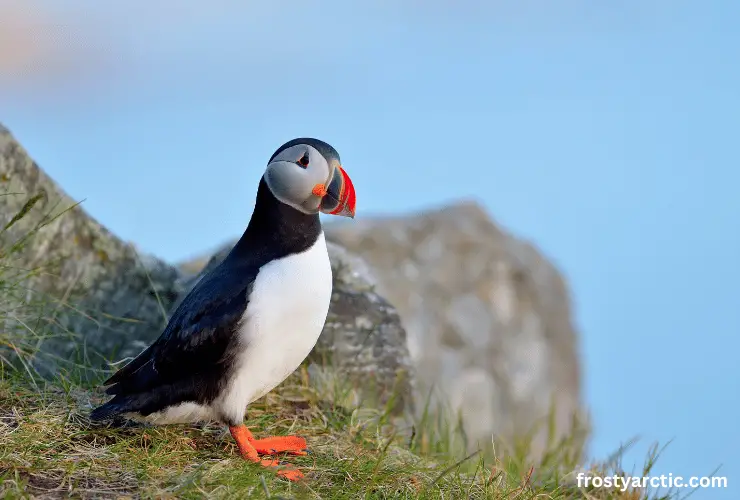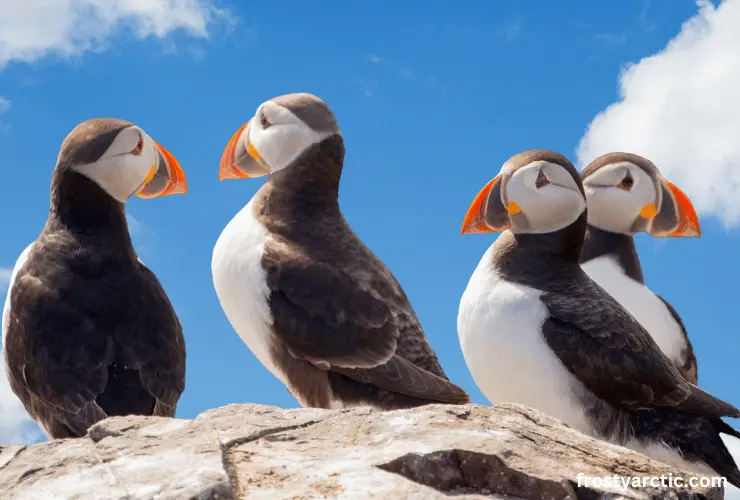Puffins are generally friendly and not known to be aggressive towards humans. However, they are wild animals, and as such, they are not accustomed to human interaction. They do not have teeth, but their beaks are sharp. So, they might peck you if they feel threatened.
But can you pet a puffin? Puffins are wild creatures inhabiting the cold, northern reaches of our world. Their friendly attitude and engaging looks often create the impression that these are pet-like birds. But is this impression accurate?
In this article, we will dive into the world of puffins, exploring their behavior, assessing their friendliness, finding out whether you could possibly pet one, and much more. So, strap in for a journey to understand these seabirds a little better!
Is a Puffin Aggressive?
Before making any assumptions, let’s understand their nature: Are puffins inherently aggressive?
● Puffins in Their Natural Habitat
When observed in their natural environments, puffins are generally not aggressive. They spend most of their lives at sea, only coming to land during the breeding season. These seabirds often socialize with their peers in large colonies, engage in playful behaviors, and share food resources.
● Puffin Interaction with Other Puffins
Interestingly, puffins are known for their strong pair bonds. Once a puffin finds a partner, they typically stick together, breeding and raising their chicks in unity. Even among their peers, puffins seldom show aggression.
As the Journal of the Lundy Field Society reported, they are more likely to engage in group behaviors, such as mutual preening and bill-tapping.
● Puffins and Human Interaction
Typically, puffins are not aggressive towards humans, but they are not used to close human interaction. Puffins might peck or attempt to flee if they feel threatened or cornered. They are more likely to show defensiveness rather than outright aggression.
Do Puffins Have Teeth? Do They Bite?

Although it may appear as if puffins have teeth, they do not. What puffins do have, however, are backward-facing, tooth-like serrations on their beaks.
These aren’t teeth in the traditional sense; they’re extensions of the beak’s outer covering or rhamphotheca. These serrations are invaluable tools for puffins, helping them carry multiple fish at once without dropping them, a spectacle that is fascinating to witness.
So, Do puffins bite?
With their fish-grasping ‘pseudo-teeth,’ one might wonder if puffins bite. Though their beaks are not designed for biting in the same way a parrot or hawk’s might be, a puffin’s beak can still deliver a strong peck.
However, instances of puffins pecking humans are rare. Puffins generally maintain their distance from humans, only becoming defensive if they feel their space is being invaded or if they are being handled without proper care.
Are Puffins Loyal?
When it comes to loyalty in the animal kingdom, puffins hold a distinguished place. These seabirds demonstrate commitment in several ways, including long-term pair bonding, parental care, and fidelity to their breeding colonies.
● Pair Bonds and Puffin Loyalty
One of the most compelling demonstrations of puffin loyalty is the strong pair bonds they form. Puffins are known for their monogamous behavior; once they find a partner, they usually stick together for life, according to a study by Oxford University.
Each breeding season, puffin pairs reunite, often returning to the same burrow year after year to raise their single chick. This behavior demonstrates a level of loyalty rarely seen in the wild.
● Puffins and Their Offspring
Their loyalty also extends to their offspring. Both parents share the responsibility of incubating the single egg and caring for their chick once it hatches, taking turns to hunt and bring back food, often small fish. This parental care continues until the chick, known as a puffling, is ready to leave the burrow and head out to sea.
● Puffin Loyalty to Colony
Puffins are also known for their loyalty to their colonies. These seabirds often nest in large colonies on cliff faces or islands, places where predators have limited access.
These seabirds display loyalty to their colonies, with some colonies consisting of hundreds of thousands of birds, by returning to the same sites every breeding season. The social interaction in these colonies is crucial to their survival and reproductive success.
Can You Touch Puffins?

Puffins are wild animals; like most wildlife, they are not accustomed to being handled by humans. The bird may become stressed or scared if you attempt to touch it. This can lead to the puffin trying to peck or flee as a defensive response.
Hence, from a puffin’s well-being perspective, touching or handling them is generally not recommended.
● Legal Considerations
In many countries, it’s illegal to touch, disturb, or handle puffins without a special permit. These laws are in place to protect wildlife and ensure that humans do not negatively impact the animals’ natural behaviors or habitats.
● Ethical Concerns
Ethically speaking, we should respect all wildlife, including puffins. The principle of “look, don’t touch” is widely promoted by conservationists and wildlife experts.
This approach enables people to appreciate wildlife from a distance, preferably using binoculars or a camera with a zoom lens. This allows us to enjoy their fascinating behaviors without causing them any distress.
Under trained professionals’ guidance, Wildlife tours also offer opportunities to see puffins in their natural habitat while ensuring their welfare is prioritized.
Can You Pet a Puffin?

Puffins are generally non-aggressive towards humans but are not domesticated animals and, therefore, not accustomed to human handling. They are wild seabirds, and their natural instincts can trigger a fear response when you come too close or attempt to touch them.
FAQs
Q: Why Are Puffins Cute?
A: Puffins often appear “cute” to humans due to their small size, bright-colored beaks, and round eyes. Their waddling walk and playful behavior, particularly during social interactions, further enhance their adorable appeal.
Q: Are Puffins Intelligent?
A: Yes, puffins are considered intelligent birds. They show problem-solving abilities, strong memory, especially in navigating back to their burrows, and advanced social behaviors such as monogamy and cooperative breeding, all indicating a high level of intelligence.
Wrapping Up
So, are puffins aggressive? Puffins aren’t typically aggressive, either in their natural habitats or towards humans. They are social, friendly birds that demonstrate fascinating behaviors. However, like all wild creatures, they require respect and space.
You might be tempted to touch a puffin due to its adorable appearance, but it’s generally not advisable. Though not aggressive, they can peck or nip if they feel threatened. Both for the puffin’s welfare and to respect legal and ethical guidelines, the best way to enjoy puffins is from a distance, observing their natural behaviors in their wild habitats.


